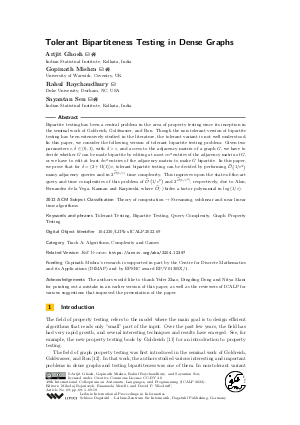@InProceedings{ghosh_et_al:LIPIcs.ICALP.2022.69,
author = {Ghosh, Arijit and Mishra, Gopinath and Raychaudhury, Rahul and Sen, Sayantan},
title = {{Tolerant Bipartiteness Testing in Dense Graphs}},
booktitle = {49th International Colloquium on Automata, Languages, and Programming (ICALP 2022)},
pages = {69:1--69:19},
series = {Leibniz International Proceedings in Informatics (LIPIcs)},
ISBN = {978-3-95977-235-8},
ISSN = {1868-8969},
year = {2022},
volume = {229},
editor = {Boja\'{n}czyk, Miko{\l}aj and Merelli, Emanuela and Woodruff, David P.},
publisher = {Schloss Dagstuhl -- Leibniz-Zentrum f{\"u}r Informatik},
address = {Dagstuhl, Germany},
URL = {https://drops.dagstuhl.de/entities/document/10.4230/LIPIcs.ICALP.2022.69},
URN = {urn:nbn:de:0030-drops-164101},
doi = {10.4230/LIPIcs.ICALP.2022.69},
annote = {Keywords: Tolerant Testing, Bipartite Testing, Query Complexity, Graph Property Testing}
}

 Creative Commons Attribution 4.0 International license
Creative Commons Attribution 4.0 International license
